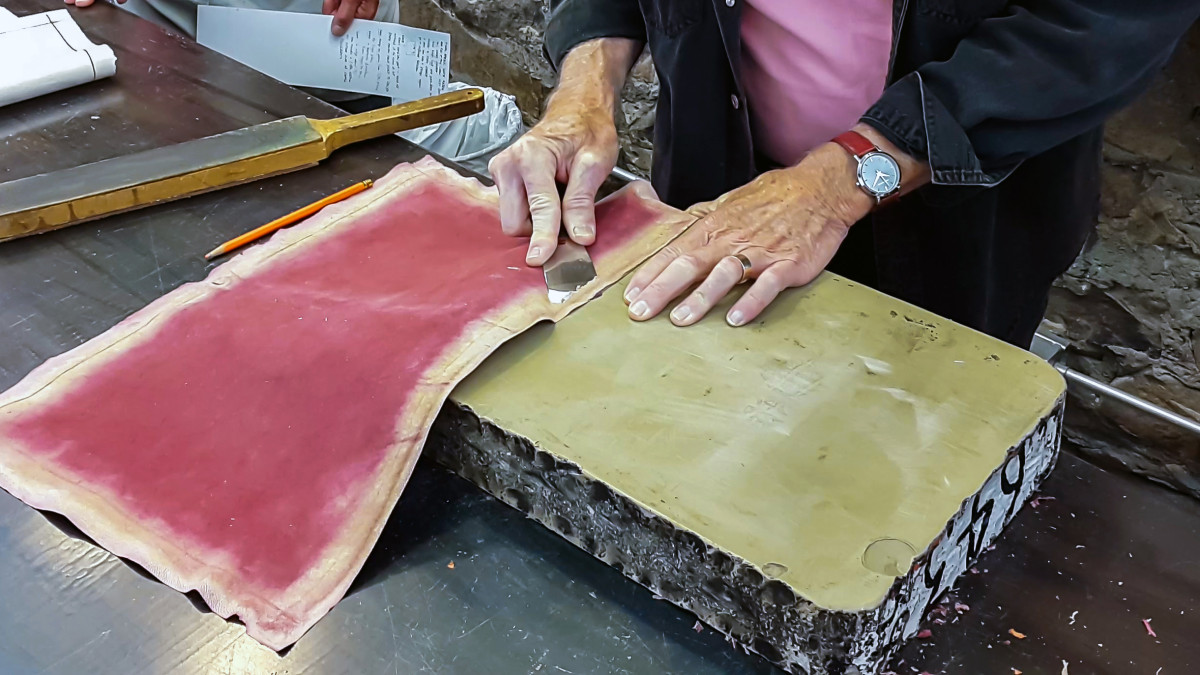Leather-Paring Stones
Paring leather is a very important stage of bookbinding process. Leather should fade away starting at some point 3 or 4 cm from the edge to the edge, and be quite thin at turn-ins. It should be pared evenly, otherwise all the little bumps would show on the surface and ruin the otherwise perfect (hopefully) book.
There are many paring techniques. Different knives and devices are used to pare leather. But there is also another important element that affects the result a lot — the surface you pare your leather on.
I’m not sure how an outsider pictures the process of paring (if he or she pictures it at all), but for many bookbinders it’s commonplace to use a lithographic stone, or a piece of lithographic limestone, to be precise. Not that all bookbinders have one — I, for instance, do not have a lithostone.
Anyway, lithographic stones are not the only option. Some bookbinders prefer other materials: glass, marble and granite, to name a few.
Just a couple of days ago, I went to a large hardware store to buy some miscellanea for our apartment. I decided to use that opportunity to get some stuff for my bookbinding workshop — including a surface for paring leather. First thing I looked for was marble, but I had no luck with that. I know that I could have bought a nice thick piece of glass, maybe even safety glass, to avoid chips and cracks. However, I decided to try something different and new — porcelain stoneware tiles.
I’m not sure I was right to decide against buying one of these gleaming glossy tiles (I thought they are more likely to chip), but I found a very flat one and brought it home. To my surprise, it worked quite well. My knife didn’t leave any dents on the surface, and paring went smoothly.
Anyway, even if I break the surface, I have four more tiles in the package =)
But there is a reason bookbinders prefer lithographic stones over marble, glass and other materials — you are less likely to break the blade. And some paring knives are quite expensive. Anyway, let me list all the options below.
Lithographic Stone
Paring on lithographic stones is supposed to be the standard option for a bookbinder. Lithographic stones are carved from hard fine-grained limestone. The stone can be sanded and polished to make the surface smooth and even.
Two main reasons bookbinders choose lithographic stones over other options for paring leather are:
- Damaged surface of the stone could be easily sanded and repaired;
- Smaller chance to break the knife — limestone is rather soft for that.
On the other hand, lithographic stones are quite heavy. For example, a 23×18 cm (9 x 7 inch) stone weighs about 6 kilograms (13 pounds). And that’s a pretty small one.
It is also not always an easy task to find (and deliver!) a lithographic stone.
Marble
Marble is almost the same thing as limestone, it really is a result of metamorphism of limestone. However, it is likely to be harder to sand. The risk of breaking or denting your knife when using a marble surface for paring is slightly higher. Marble is also more expensive. At least in the US and Europe. In some countries (like Russia) lithographic stones are rare and could be quite expensive.
Glass
Glass gives you a nice smooth surface for paring the leather. However, you should be careful in choosing the type of glass you plan to use. It would be unwise to buy anything that breaks easily. Small chips of glass may injure you and ruin your leather.
On the other hand, there are lots of types of safety glass unlikely to chip or break.
I would also cite Jeff Peachey’s blog here on paring leather on a glass surface:
Charles Tomas Jacobi The Printers’ Handbook of Trade Recipes, Hints & Suggestions (London: Chiswick Press, 1891), 265.
Yes, yes, and yes. Note there is no mention of a litho stone. 18th century paring surfaces seem to generally be marble, I suspect the only reason litho stones became popular was that they were a cheap plentiful source of a flat surface in the late 19th. Save the litho stones for the printers or your beautiful bookbinding photography.
Metal
Some bookbinders use just any flat and sufficiently hard surface they can find. Steel plates, for example. The main problem with that kind of surface is that the risk of ruining your knife is very high.

Other Materials
In the very beginning of my bookbinding experience, I pared leather on any surface I could find, including cardboard, laminated flooring and hard wood. The problem is, you not only risk dulling your knife too fast, there is also a high possibility of cutting the leather instead of paring it.
I’m not sure if I should put my tiles of porcelain stoneware here. Finally, they are made to withstand the assault of kitchenware, including knives. My own experiments show that it is possible to find a rather smooth stoneware that wouldn’t chip or break while paring leather.
I hope you will share your experience with paring surfaces in the comments section below =)
Please Support us on Patreon!

Moreover, starting with the pledge level of $3, you will get a digitized vintage book about bookbinding, book history, or book arts each month from us!
These pledges help iBookBinding to continue its work and bring more information about bookbinding and book arts to you!



![screen-shot-2014-02-23-at-5-08-12-pm[1]](https://i0.wp.com/www.ibookbinding.com/wp-content/uploads/2015/10/screen-shot-2014-02-23-at-5-08-12-pm1.png?resize=471%2C79)
